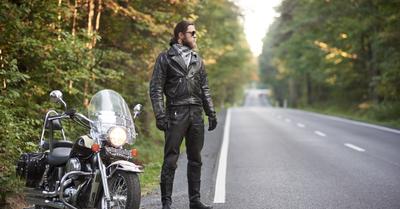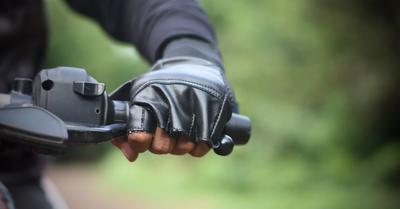What is a Honda Rebel 1100?
The Honda Rebel 1100 is a cruiser-style motorcycle made by the Japanese manufacturer Honda. The motorbike is designed to appeal to riders who want a motorcycle that can endure long trips and entry-level enthusiasts who need a dependable daily driver.
While powered by a 1084cc parallel twin engine tweaked from their Africa Twin adventure motorbike, this motor produces 86 hp and 72 lb-ft of torque. Honda sought to satisfy serious cruisers without sacrificing the appeal of new riders who had been so enthralled with the 500. While we wished for a bit longer range, the 3.6-gallon tank with a 1.1 reserve means that the Rebel has a limited range of about 162 miles to empty despite getting nearly 45 mpg.
To help ease the transition of new riders, Honda added cruise control, selectable driving modes, and the option of a new DCT transmission. While the purist might not care for a bike that does need to be manually geared, there are plenty of reasons to offer a self-shifting motorcycle. Honda recognizes that we are all a part of the riding community, and even seasoned cruisers can develop conditions that prevent them from riding a bike with a clutch. (For example, I know of a rider who broke his ankles and can’t tap the clutch pedal with his foot without experiencing severe pain). The drive modes help center the riders' intentions, and while they take some getting used to, these options help keep the appeal of the Rebel alive and well for novice riders.
The ride is smooth. At 27.5 inches, the rider sits perfectly on the bike, not slumped over the gas tank or set so far back that it's a reach to grab the handlebar. With a lower center of gravity, the heaviest parts of the engine are set in just the right spot to aid the bike's balance. The position is upright, comfortable, and mainly centered for the daily commuter caught in the flow of stop-and-go congestion. The bike is narrow enough to split the lanes, but as anyone who rides knows, you risk a ticket. (Invariably, there always seems to be a highway patrol officer just waiting at the front of the line, pointing at you to pull over and receive your ticket).
The problem with most cruisers is that they cannot deliver when you need them to, but the Rebel is not such a bike. Even as light as it is (487 lbs), the motorcycle is responsive to commands, laying down rubber when needed and moving through curves with the ease of a sport bike. I was surprised at how agile the bike was, thinking it would ride more like the Gold Wing cruisers that Honda is known for, but it didn’t. The tires gripped well, evacuated water on wet pavement, kept their cohesion, and tended to gobble up the miles on every straightaway they saw. The only drawback to the Rebel is some vibration when riding over
bumps and imperfections of the road. The bike loves the open road. It just needs to be smooth pavement all the way. Even with this slight drawback, it is easy to see why the Rebel offers so much value. Honda might be racking up the chips for a long time.
(Authors note - there is a recall on the radiator cap for the 2021 Honda Rebel 1100 - be sure to check with your local dealer to see if your bike is included).
What are the Best Tires for a Honda Rebel 1100?
Several manufacturers produce quality tires for the Honda Rebel. Here are some of our favorites.
Metzeler Cruisetec
Metzeler is known for making quality cruiser tires. With an effective tread pattern, the deep siping helps to move water away from the center so that there is additional grip on wet surfaces.
The Cruisetec provides excellent stability through corners by providing additional traction on the sidewall. The dual compound provides an excellent structure to the tire, increasing its tread life.
This German-made tire has been around for a couple of years and seems to be rising in popularity. The Cruisetec is the top seller in Metzeler’s line of cruising tires, and this tire is a top staff pick by Revzilla. The treadwear is excellent, and it is not uncommon for a rider to get over 10,000 miles on Metzeler tires. There is a reason that the tire is one of the most sought-after tires on the market.
Metzeler is owned by tire manufacturer Pirelli (who also has quite a reputation for building quality tires). While the company is better known for its substantial presence in Europe, it is gaining steam here in the states. A rider could do much worse than a Metzeler for a tire that lasts.
Rating
- The tire has a 4.5 rating on Revzilla.com
Load and Weight Limits
- The load rating for the front tire is 63, or 600 lbs.
- The load rating for the rear tire is 81 or 1,019 lbs.
- The max speed limit is H or 130mph.
Pros
- A top-rated tire on numerous review sites
- Quite popular in Europe
- Number one replacement tire for stock Dunlops
Cons
- Made overseas - may be challenging to get.
Price
- For more information, please visit the manufacturer’s website
- Check here for Today’s Price on revzilla.com
Shinko 777 - Heavy Duty
Shinko makes tires for cruiser motorcycles, and they have a wide selection. Their unique compound is designed to maximize the grip of the tread on wet or dry surfaces. The tire is sold for the Honda Rebel as an HD, which means the carcass has been reinforced for additional stability. The wide rear tire provides the support that new riders need. In addition, the Shinko 777 is built for long and heavy loads, as most cruisers will have additional weight in saddlebags or with an additional rider.
Shinko tires are DOT approved, so they are street-legal in the US. In addition, the tire is a top-rated tire from Revzilla.
Shinko is a Japanese rubber company that began making bicycle tires and tubes. In 1998, they purchased the tire company from Yokohama and now have a production facility in South Korea. The company makes about 200,000 tires monthly. Their American headquarters is in Boise, Idaho, with distribution centers across the US.
Rating
- The tire has a 4.5 rating on Revzilla.com
Load and Weight Limits
- The load rating for the front tire is 62 or 584 lbs.
- The load rating for the rear tire is 81 or 1,016 lbs.
- The max speed limit is H or 130 mph.
Pros
- South Korean/Japanese joint venture
- The tire has an exceptional tread life
- Very stable tire
Cons
- Not well known in the states
Price
- For more information, please visit the manufacturer’s website
- Check here for Today’s Price on revzilla.com
Dunlop American Elite
Dunlop is the only American producer of motorcycle tires. The company designs, tests, and manufactures the tire out of its factory in Buffalo, NY. These are the replacement tires for Harley Davidson cruisers, but they will also work on the Rebel. They are made with a long-lasting compound specially made for longevity and mileage, which is very important for riders who need to get as many miles out of their tires as possible. The shoulders of the tire have been reinforced to provide stability when turning and additional traction for various street conditions.
(One of the best things I like about Dunlops is that every tire that comes off the factory line is hand-checked before it is shipped. I like that a pair of eyes give my tire the once over. It might not mean much, but it makes me feel better).
Dunlop is a British company named for the maker of the pneumatic bicycle tire in the late 1890s. A year later, the company formed and began to produce them, and it wasn’t long until they began to make tires for the emerging auto industry. Over the years, it has had various owners, been part of the Goodyear family, and recently came under the control of Sumitomo Rubber Company.
Rating
- The tire has a 4.8 rating on Revzilla.com
Load and Weight Limits
- The load rating for the front tire is 65 or 639 lbs.
- The load rating for the rear tire is 81 or 1,016 lbs.
- The max speed limit is H or 130 mph.
Pros
- The tire is made in the US
- Very stable tire
- High rating on Revzilla
Cons
- The company is not the US owned
Price
- For more information, please visit the manufacturer’s website
- Check here for Today’s Price on revzilla.com
Continental Conti-Tour
This is a practical reinforced cruising tire that is made for the road. Built with dual belts, nylon, and aramid piles, the tread is designed to last and not wear out. The broad nature of the rear tire gives exceptional grip during wet pavement and will handle heavy loads with little problem. The grooves on the tread are more profound than other tires, allowing for better water evacuation, while the clean center strip keeps the bike centered. The ride is softer than most tires during acceleration and exhibits precise, spot-on handling for curves. Continental is the way to go if you need a pair of tires you want just to put on your bike and forget about them. The tires are also eligible for Continental’s free three-year road assistance warranty, so the tires can be replaced if there is an issue. ,
(Unfortunately, Continental has been plagued with a recent major recall for many of its TKC80 and ContiGo! Brands, but the Conti-Tour is not included in the list, so they should be just fine).
Continental is the fourth largest tire manufacturer in the world. While they now make much more than just tires, they started as a tire company in 1871. Their single-tread tire was used in many early vehicles and brought the company instant accreditation. While Continental makes quality tires, they have been producing motorcycle tires in Hanover, Germany, for decades.
Rating
- The tire has a 4.4 rating on Revzilla.com
Load and Weight Limits
- The load rating for the front tire is 63 or 600 lbs.
- The load rating for the rear tire is 81 or 1,016 lbs.
- The max speed limit is H or 130 mph.
Pros
- Reinforced tread holds up longer
- Very stable tire - designed for heavy loads
Cons
- Made overseas in Hanover
Price
- For more information, please visit the manufacturer’s website (the link is down temporarily)
- Check here for Today’s Price on Revzilla.com
Michelin Scorcher 31
This tire has been around for several years and is the OEM tire for many Harley Davidson cruisers, but it also fits on the Honda Rebel 1100. This tire has a center groove connected to the outer siping that will shed water like nobody’s business. The Scorcher has excellent grip on wet pavement, and the rubber compound that Michelin uses effectively provides just the right amount of cushion to handle the imperfections in the pavement that motorcycles seem to find. The grip on any road surface is good, and the tire can surprisingly handle different temperatures.
Michelin is a French multinational that has been making tires since 1889. Today, the company has grown into a global giant, with 123 production centers in 26 countries and employing over 124,000 workers worldwide.
Rating
- The tire has a 4.7 rating on Revzilla.com
Load and Weight Limits
- The load rating for the front tire is 63 or 600 lbs.
- The load rating for the rear tire is 81 or 1,016 lbs.
- The max speed limit is H or 130 mph.
Pros
- Michelin makes a great tire
- This tire sheds water - great for wet pavement
Cons
- Made overseas
Price
- For more information, please visit the manufacturer’s website
- Check here for Today’s Price on Revzilla.com
Bridgestone Battlecruise H50 Tires
Over the past decade, the primary problem with cruiser tires is that riders often had to choose between longevity and grip. Either you could purchase a tire that lasted but didn’t hold as well on the pavement or a tire with a super grip that you needed to replace every so often. Bridgestone recognizes this issue and offers a healthy compromise. This HG50 is a balanced tire that offers the best of both worlds.
Bridgestone Battlecruise H50s are the big boy tires of heavy cruisers. About five years ago, Bridgestone recognized the need to attack the cruiser market in the US (more than half of the motorcycles sold in the states are cruisers and are expected to grow to $101.9 billion by 2030 ).
The tire is an effective long-distance unit that will wear well and keep its wits about it when called on for acceleration or handling. The ride is smooth and gentle, and the tire absorbs shocks without feeling them in the rider's spine whenever the bike goes over one. You want to put miles on this tire because it holds up better than others.
Bridgestone is the number one manufacturer of the tire in the world. The company merged with Firestone to grow into a significant global supplier of all kinds of tires. The giant currently has over 130 manufacturing plants in over 150o countries, so it is easy to see why its brand is so famous - mainly because their tires are everywhere.
Rating
- The tire has a 4.7 rating on Revzilla.com
Load and Weight Limits
- The load rating for the front tire is 63 or 600 lbs.
- The load rating for the rear tire is 81 or 1,016 lbs.
- The max speed limit is H or 130 mph.
Pros
- The largest manufacturer of tires in the world
- Average price compared to other competitors
Cons
- Made overseas
Price
- For more information, please visit the manufacturer’s website
- Check here for Today’s Price on Revzilla.com
What are the Signs that My Motorcycle Tires Need Replacing?
There are several ways a rider can inspect and determine if the tires on their bike need to be replaced. If you don’t ride constantly, it is always a good idea to inspect your tires before setting out on any cruise.
The Tire Needs Air
If you walk out to your garage and notice a low tire, you should never ride on it. Instead, pump the tire with enough air to make it have standard psi and inspect the tread. More than likely, there is a reason why the tire has lost some of its pressure. Look for a puncture or a tear, or even listen to see if you can determine where the leak is coming from.
Many technicians fill a squirt bottle with soapy water and spray the tire with the compound. Any leak will be revealed because the tire will begin to show air bubbles where it is leaking. Look for a series of tiny soap bubbles on the surface where your leak is.
If the leak comes from the tire's sidewall, you must replace the tire. Even though it is possible to plug a small leak on a tubeless tire, a sidewall leak can never be fixed. (In fact, we don’t recommend plugging a motorcycle tire no matter where the puncture is). Unlike automobile tires, motorcycle tires are more delicate, and it is impossible to know what damage has been done to the interior of the bike tire. So, we recommend that you consider replacing them, for safety’s sake.
The Tire has a Wart on the Side.
Even the best motorcyclist runs against something now and then. Often, scraping a curb or parking block can cause damage to the sidewall. You must do tire shopping if you notice a bubble on the sidewall (think a tire aneurysm). Do not ever ride a bike with a tire wart, even if it is just to the repair shop.
The Tire is showing Cracking or Feathering.
If you haven’t ridden in a while, you need to look for signs of dry rot. This condition is exhibited by tiny cracks or discoloration of the tire. If you see feathering, like tiny blood vessels or roots running over the surface of the tire, then you should replace the tire.














